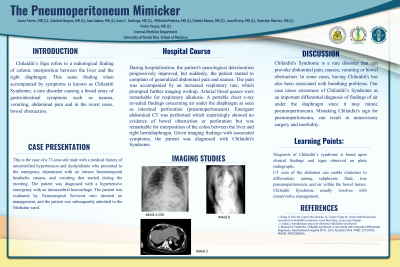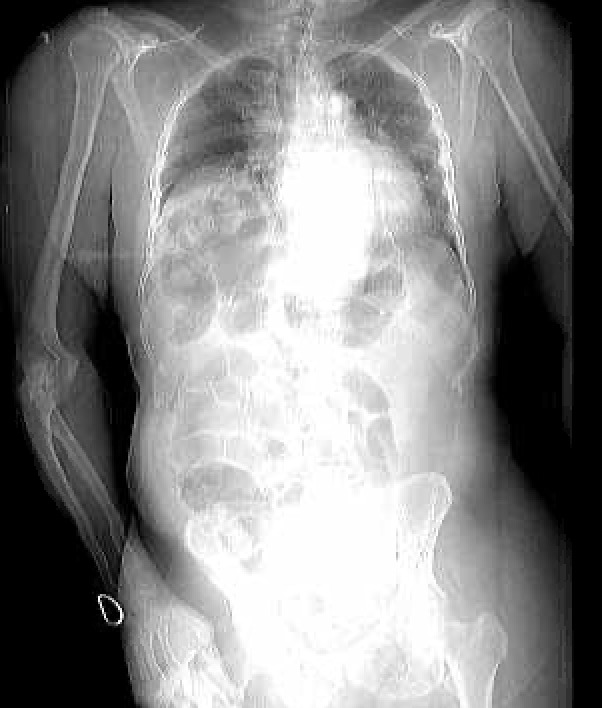Back


Poster Session B - Monday Morning
Category: Colon
B0112 - The Pneumoperitoneum Mimicker
Monday, October 24, 2022
10:00 AM – 12:00 PM ET
Location: Crown Ballroom

Has Audio

Lorna M. Torres-Rosario, MD
University of Puerto Rico, Medical Sciences Campus
San Juan, Puerto Rico
Presenting Author(s)
Lorna M. Torres-Rosario, MD1, Gabriela M. Negron-Ocasio, MD2, Juan J. Adams Chahin, MD2, Juan C. Santiago-Gonzalez, MD2, Wilfredo Pedreira-Garcia, MD3, Juan J. Rivera Torres, 4, Pedro Vargas-Otero, MD1, Gretchen Marrero-Lozada, MD5
1University of Puerto Rico, Medical Sciences Campus, San Juan, Puerto Rico; 2University of Puerto Rico Medical Sciences Campus, San Juan, Puerto Rico; 3VA Caribbean Health Care System, San Juan, Puerto Rico; 4University of Puerto Rico School of Medicine, San Juan, Puerto Rico; 5University of Puerto Rico, University District Hospital, San Juan, Puerto Rico
Introduction: Chilaiditi’s Sign refers to a radiological finding of colonic interposition between the liver and the right diaphragm. This same finding when accompanied by symptoms is known as Chilaiditi’s Syndrome, a rare disorder causing a broad array of gastrointestinal symptoms such as nausea, vomiting, abdominal pain and in the worst cases, bowel obstruction.
Case Description/Methods: This is the case of a 73-year-old male with a medical history of uncontrolled hypertension and dyslipidemia who presented to the emergency department with an intense frontotemporal headache, nausea, and vomiting that started during the morning. The patient was diagnosed with a hypertensive emergency with an intracerebral hemorrhage. The patient was evaluated by Neurosurgical Serviced who deemed no management, and the patient was subsequently admitted to the Medicine ward. During hospitalization, the patient's neurological deterioration progressively improved, but suddenly, the patient started to complain of generalized abdominal pain and nausea. The pain was accompanied by an increased respiratory rate, which prompted further imaging workup. Arterial blood gasses were remarkable for respiratory alkalosis. A portable chest x-ray revealed findings concerning air under the diaphragm as seen as intestinal perforation (pneumoperitoneum). Emergent abdominal CT was performed which surprisingly showed no evidence of bowel obstruction or perforation but was remarkable for interposition of the colon between the liver and right hemidiaphragm. Given imaging findings with associated symptoms, the patient was diagnosed with Chilaiditi's Syndrome.
Discussion: Chilaiditi's Syndrome is a rare disorder that can provoke abdominal pain, nausea, vomiting or bowel obstruction. In some cases, having Chilaiditi's has also been associated with breathing problems. Our case raises awareness of Chilaiditi’s Syndrome as an important differential diagnosis of findings of air under the diaphragm since it may mimic pneumoperitoneum. Mistaking Chilaiditi's sign for pneumoperitoneum, can result in unnecessary surgery and morbidity.

Disclosures:
Lorna M. Torres-Rosario, MD1, Gabriela M. Negron-Ocasio, MD2, Juan J. Adams Chahin, MD2, Juan C. Santiago-Gonzalez, MD2, Wilfredo Pedreira-Garcia, MD3, Juan J. Rivera Torres, 4, Pedro Vargas-Otero, MD1, Gretchen Marrero-Lozada, MD5. B0112 - The Pneumoperitoneum Mimicker, ACG 2022 Annual Scientific Meeting Abstracts. Charlotte, NC: American College of Gastroenterology.
1University of Puerto Rico, Medical Sciences Campus, San Juan, Puerto Rico; 2University of Puerto Rico Medical Sciences Campus, San Juan, Puerto Rico; 3VA Caribbean Health Care System, San Juan, Puerto Rico; 4University of Puerto Rico School of Medicine, San Juan, Puerto Rico; 5University of Puerto Rico, University District Hospital, San Juan, Puerto Rico
Introduction: Chilaiditi’s Sign refers to a radiological finding of colonic interposition between the liver and the right diaphragm. This same finding when accompanied by symptoms is known as Chilaiditi’s Syndrome, a rare disorder causing a broad array of gastrointestinal symptoms such as nausea, vomiting, abdominal pain and in the worst cases, bowel obstruction.
Case Description/Methods: This is the case of a 73-year-old male with a medical history of uncontrolled hypertension and dyslipidemia who presented to the emergency department with an intense frontotemporal headache, nausea, and vomiting that started during the morning. The patient was diagnosed with a hypertensive emergency with an intracerebral hemorrhage. The patient was evaluated by Neurosurgical Serviced who deemed no management, and the patient was subsequently admitted to the Medicine ward. During hospitalization, the patient's neurological deterioration progressively improved, but suddenly, the patient started to complain of generalized abdominal pain and nausea. The pain was accompanied by an increased respiratory rate, which prompted further imaging workup. Arterial blood gasses were remarkable for respiratory alkalosis. A portable chest x-ray revealed findings concerning air under the diaphragm as seen as intestinal perforation (pneumoperitoneum). Emergent abdominal CT was performed which surprisingly showed no evidence of bowel obstruction or perforation but was remarkable for interposition of the colon between the liver and right hemidiaphragm. Given imaging findings with associated symptoms, the patient was diagnosed with Chilaiditi's Syndrome.
Discussion: Chilaiditi's Syndrome is a rare disorder that can provoke abdominal pain, nausea, vomiting or bowel obstruction. In some cases, having Chilaiditi's has also been associated with breathing problems. Our case raises awareness of Chilaiditi’s Syndrome as an important differential diagnosis of findings of air under the diaphragm since it may mimic pneumoperitoneum. Mistaking Chilaiditi's sign for pneumoperitoneum, can result in unnecessary surgery and morbidity.

Figure: Chilaiditi's sign
Disclosures:
Lorna Torres-Rosario indicated no relevant financial relationships.
Gabriela Negron-Ocasio indicated no relevant financial relationships.
Juan Adams Chahin indicated no relevant financial relationships.
Juan Santiago-Gonzalez indicated no relevant financial relationships.
Wilfredo Pedreira-Garcia: Bitcoin – Stock Options. Disney – Stock Options. Ethereum – Stock Options. KO – Stock Options. Meta – Stock Options. Nvidia – Stock Options. Tesla – Stock Options.
Juan Rivera Torres indicated no relevant financial relationships.
Pedro Vargas-Otero indicated no relevant financial relationships.
Gretchen Marrero-Lozada indicated no relevant financial relationships.
Lorna M. Torres-Rosario, MD1, Gabriela M. Negron-Ocasio, MD2, Juan J. Adams Chahin, MD2, Juan C. Santiago-Gonzalez, MD2, Wilfredo Pedreira-Garcia, MD3, Juan J. Rivera Torres, 4, Pedro Vargas-Otero, MD1, Gretchen Marrero-Lozada, MD5. B0112 - The Pneumoperitoneum Mimicker, ACG 2022 Annual Scientific Meeting Abstracts. Charlotte, NC: American College of Gastroenterology.
